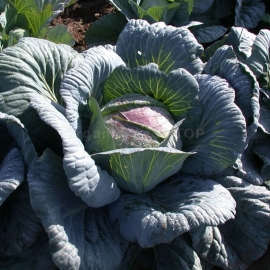
«Amager 611» - Organic Cabbage Seeds
1.14 €
White cabbage "Amager 611" (Brassica oleracea convar. capitata var. alba) is a late variety that produces slightly flattened heads consisting of dark green leaves covered sparsely with waxy coating. The "Amager 611" variety does not break.
-
Organic Cabbage «Amager 611»
White cabbage "Amager 611" (Brassica oleracea convar. capitata var. alba) is a late variety that produces slightly flattened heads consisting of dark green leaves covered sparsely with waxy coating.
The "Amager 611" variety does not break, hence is ideal for winter storing and pickling. It may also be consumed directly in salads or as addition to many dishes. White head cabbage is an important source of vitamins C, A, PP, B vitamins, as well as kalium, calcium, magnesium and iron. Cabbage leaves contain plenty of proteins, carbohydrates and fibre. White cabbage juice strengthens the body and is recommended for people fighting anemia.
How to Grow
Sow seeds indoors 6 to 8 weeks before average last spring frost. Keep soil warm (about 75 F) until germination. Then keep plants around 60 F. Provide direct sun so plants don't get leggy. When plants are 4 to 6 weeks old, transplants into garden 12 to 24" apart, in rows 18 to 34" apart. Use closer spacing for smaller, early varieties, wider spacing for larger, late-season varieties. Can be direct seeded as soon as you can work the soil. Will germinate at soil temps as low as 40 F. Plant ¼ to ½ inch deep, about 3 inches apart.
Thin to final spacing. Direct seed in summer for fall crop, or start transplants in late May and transplant in late June or early July. Plants have shallow root systems. Avoid even shallow cultivation. Mulch to protect roots, reduce weed competition and conserve moisture. Use floating row cover to protect crop from early pests.
When heads are mature, they are prone to splitting in response to any stress or a rain following a dry period. Avoid splitting by choosing varieties that resist splitting, spacing plants close together (8 to 12 inches for early varieties, 12 to 16 inches for later varieties), using shovel to sever roots on one side about 6 inches from the plant, or twisting plants after heads have firmed to break some of the roots.
To help reduce disease, do not plant cabbage or other cole crops in the same location more than once every three or four years. When cabbages are 4 to 5 inches tall, thin or transplant to stand 18 to 24 inches apart. Apply a thick layer of mulch to retain moisture. Water plants during the summer if rainfall is less than 1 inch per week. Contact your local county extension office for controls of common cabbage pests such as aphids, root maggots, cabbage-worms, and cabbage loopers.
